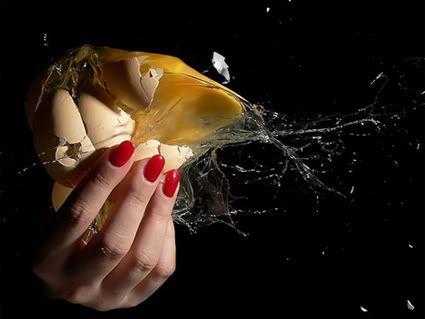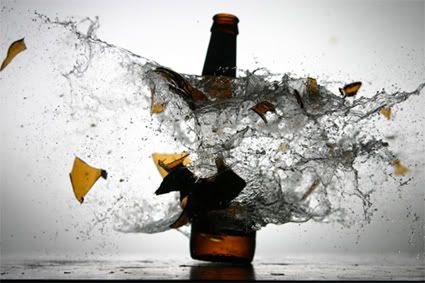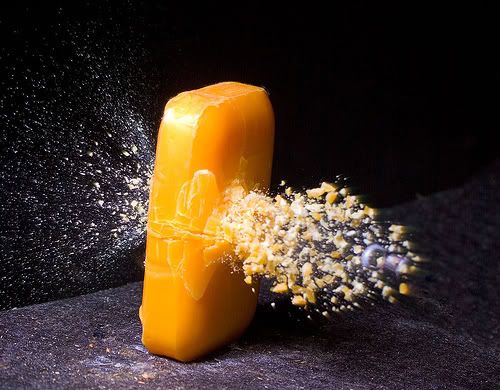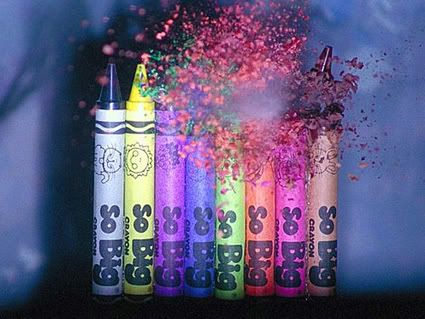Deep Deep Smashing

It's as though the creative process is no longer contained within an individual skull, if indeed it ever was. Everything, today, is to some extent the reflection of something else.
--William Gibson, Pattern Recognition
Everyone knows you can't cry over spilled milk. But, apparently, you can observe its recursive patterns.
I suspect it's no surprise if regular OT readers, at least those with a more highly developed sense of pattern recognition, see fractal patterns when things are smashed or blown up.
Other people have sure noticed. Some have been exploring computing methodologies that use fractal analysis to explore seismological patterns of underground nuclear explosions. Others claim our sun sends us fractal twitters about its storm seasons and note that
Every 11 years, the Sun experiences its own "storm season," with violent explosions in its atmosphere, with an energy equivalent to a billion megatons and travelling towards Earth at about 1 million km per hour (about 0.05% the speed of light), though sometimes much faster.
Predicting such events is not easy, but now, plasma astrophysicists at the University of Warwick have found that key information about the Sun's "storm season" is being broadcast across the solar system in a fractal snapshot imprinted in the solar wind.
And still others work overtime to decode the universe and insist the Big Bang, the mother of all deep smashing, expanded into fractal space grids:
Even more interesting is [Charles] Seife's illustration that mathematical formulas for the expansion of gases (following fractal patterns, actually) are exactly like equations for the transmission of information. Fractals, fractals, everywhere and every bit is real. Let's consider the Big Bang. When the Bang occurred (or God lit a giant match), it threw out information bits that spread via explosive expansion in fractal pattern(s). When it is finished expanding and all of the bits of info are evenly distributed throughout forever-ness, the universe will be dark and empty and the light of Genesis will no longer "be". This is entropy -- until the next match strikes.
This post looks at what happens in the instant after a match is struck. Such a glimpse is only possible due to the window on nature provided by high-speed photography. Does this process call up an image of a slo-mo bullet lazily imploding a watermelon? Well, high-speed photography is now as many iterations beyond such grainy super slow blow-outs as today's laptops are removed from those wall-sized, blinking light computers seen in early episodes of The Man from U.N.C.L.E.
The best place I know to sift through the next wave of high-speed photography is a Flickr group dedicated to the art. Most of the photos below had their origins in this open community, although a few were found on other web sites.
And, before we start the tour, let's ask: what's the point? Well, I want your eyes to back up mine. After looking at fractals for over ten years, these everyday objects, captured and frozen in the moment of impact, reveal familiar patterns of self-similarity and characteristics of recursion I've seen again and again in generators. After all, if the Big Bang can be visualized out of algorithms, then why not a detonated egg?
We know fractals can be deep zoomed. But can fractal forms also appear when the things of this world are deep smashed?
And who are you going to believe? Me? Or your lying eyes?

Egg. High-speed photography by Stefan (photofrog).
Exploded objects, naturally it seems, burst into self-similar bits. High-speed photography captures a tableau revealing such fractal properties before debris is too far-flung. Here, the eggshell breaks into self-similar sections as the yolk is pulled into a triangle and the "egg white" becomes dendrites.

Beer Bottle. High-speed photography by Johnny Chung Lee.
Beer bottles have always blown up real good making them a staple of Western saloon brawls. Again, the glass shards here quickly become self-similar projectiles, and the liquid splays out in a recognizable fractal pattern. Don't take my word for it. Compare the pattern to the central form in this fractal image by Janet Parke.

Antibacterial Soap Bar. High-speed photography by Jasper Nance.
You don't need to squint to see the self-similarity here in bashed forward (head) and backward (tail) patterns not unlike splatters from entrance and exit "wounds."

Crayons. High-speed photography by spyzter. Image credit by Khuong.
This time the self-similar chunks nova outward in a semi-spiral from the calm eye. Coloring gradients got nothing on this one.

Computer Chip. High-speed photography by Pulse Phototronics.
The mound erupting from the corner of the chip reminds me of some of the 3D quats I've seen in QuaSZ (like this). Or is this photograph a wish fulfillment Rorschach after enduring another day of Vista?
What do you think? Do you see what I see? I certainly hope the patterns I recognize are not contained to my skull only.
Tags: fractal, fractals, fractal art, fractal blog, high-speed photography, pattern recognition, william gibson, my skull or yours, iterating over spilled milk, cruelanimal, orbit trap




0 Comments:
Post a Comment
<< Home